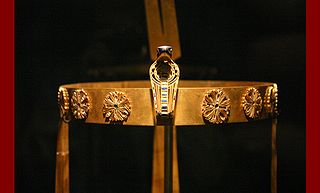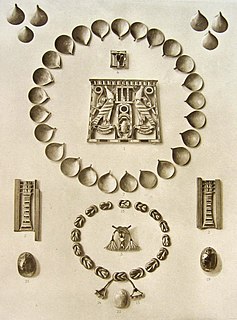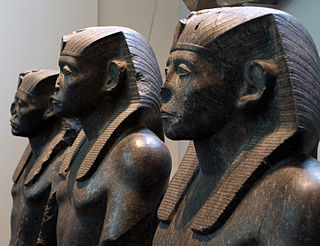
Amenemhat III, also spelled Amenemhet III, was a pharaoh of the Twelfth Dynasty of Egypt. He ruled from c. 1860 BC to c. 1814 BC, the highest known date being found in a papyrus dated to Regnal Year 46, I Akhet 22 of his rule. His reign is regarded as the golden age of the Middle Kingdom. He may have had a long coregency with his father, Senusret III.

The Middle Kingdom of Egypt is the period in the history of ancient Egypt following a period of political division known as the First Intermediate Period. The Middle Kingdom lasted from around 2050 BC to around 1710 BC, stretching from the reunification of Egypt under the reign of Mentuhotep II of the Eleventh Dynasty to the end of the Twelfth Dynasty. The Eleventh Dynasty ruled from Thebes and the Twelfth Dynasty ruled from el-Lisht. Some scholars also include the Thirteenth Dynasty of Egypt wholly into this period as well, in which case the Middle Kingdom would finish around 1650, while others only include it until Merneferre Ay around 1700 BC, last king of this dynasty to be attested in both Upper and Lower Egypt. During the Middle Kingdom period, Osiris became the most important deity in popular religion. The Middle Kingdom was followed by the Second Intermediate Period of Egypt, another period of division that involved foreign invasions of the country by the Hyksos of West Asia.

The Twelfth Dynasty of ancient Egypt, is often combined with the Eleventh, Thirteenth and Fourteenth Dynasties under the group title Middle Kingdom.

Sithathoriunet was an Ancient Egyptian king's daughter of the 12th dynasty, mainly known from her burial at El-Lahun in which a treasure trove of jewellery was found. She was possibly a daughter of Senusret II since her burial site was found next to the pyramid of this king. If so, this would make her one of five known children and one of three daughters of Senusret II—the other children were Senusret III, Senusretseneb, Itakait and Nofret.
Neferthenut was an Ancient Egyptian queen of the Twelfth Dynasty. She was most likely the wife of Senusret III.
Neferu was an ancient Egyptian queen of the 12th Dynasty. She was a daughter of Amenemhat I, sister-wife of Senusret I and the mother of Amenemhat II.

Khenemetneferhedjet I Weret was an ancient Egyptian queen of the 12th Dynasty, a wife of Senusret II and the mother of Senusret III.
Khenemetneferhedjet II(Weret) was an ancient Egyptian queen of the 12th dynasty, a wife of Senusret III.
Sobekemhat was an Ancient Egyptian treasurer under the king Senusret III in the Twelfth Dynasty. Sobekemhat is only known from his mastaba excavated in 1894 next to the pyramid of Senusret III at Dahshur. The mastaba was decorated on the outside with reliefs. These were only found in small fragments, but the fragments record the name and the titles of Sobekemhat. On an offering table he bears the title of the treasurer. The mastaba is in a chain of three mastabas, north of the king's pyramid. It is closest to the pyramid. The next mastaba belongs to the vizier (Nebit) and the third to another high official, perhaps again a vizier. Therefore, it can be argued that Sobekemhat's tomb was the earliest of the three. For a long time it was thought that Sobekemhat was vizier, but the relief fragments with the vizier's title come from the mastaba of Nebit nearby.
Nebit was an Ancient Egyptian official during the reign of king Senusret III. He held the position of vizier. Thus he was the most important official at the royal court. Nebit is only known from his large mastaba which was excavated next to the pyramid of the king at Dahshur. The mastaba was built of mud bricks and then covered with stones. Already in ancient times the high quality stone was looted and used for other building projects or just for burning lime. However, one wall of the mastaba facade had already collapsed and had been covered by sand before looters dismantled the rest of the building. The preserved facade bears the name and title of Nebit, but also the name of the king. Within the remains of the mastaba were found by Jacques de Morgan the bust of a statue made of granodiorite. The fragment is unscribed but most likely depicts Nebit.

Sithathor was an Ancient Egyptian princess with the title king's daughter. She is only known from her burial at Dahshur. Next to the pyramid of king Senusret III were found underground galleries as a burial place for royal women. Most of the burials were found looted, but there were two boxes for jewellery overlooked by tomb robbers. Both boxes contained an outstanding collection of jewellery. They were called the first and the second treasure of Dahshur. The first treasure was discovered on 6 March 1894 and belonged most likely once to Sithathor. Several scarabs with her name were found. The treasure contained a pectoral with the names of king Senusret II, one of the masterpieces of Egyptian goldwork. Other objects were golden shells, golden bracelets, a mirror and several stone vases. Sithathor is not known for sure outside her tomb. She was perhaps a daughter of Senusret III, but it is also possible that she was the daughter of Senusret II and buried as sister of king Senusret III next to him.
Menet was an Ancient Egyptian king's daughter living in the Twelfth Dynasty most likely under the kings Senusret III and Amenemhat III. Menet had the titles king's daughter and the one united with the white crown (Khenemetneferhedjet). She is only known from her sarcophagus and burial in a gallery tomb buried with other members of the royal family next to the pyramid of Senusret III at Dahshur. From the position of the tomb it seems likely that she was the daughter of the latter king.

The Pyramid of Senusret III is an ancient Egyptian pyramid located at Dahshur and built for pharaoh Senusret III of the 12th Dynasty.

Mereret was an Ancient Egyptian King's Daughter known from her burial next to the Pyramid of Pharaoh Senusret III at Dahshur. On the north side of the king's pyramid was a row of four pyramids belonging to the king's wives. These pyramids were connected by an underground gallery. On the west side of the gallery were further burials arranged for women with the title king's daughter. They were buried in sarcophagi that were placed into niches. All burials were found looted. However, the robbers missed two boxes filled with personal adornments found in 1894 by Jacques de Morgan. One of these boxes must have belonged to a king's daughter Sithathor, the other box to a king's daughter with the name Mereret or Meret.
Senetsenebtysy was an Ancient Egyptian king's daughter of the Twelfth Dynasty, around 1800 BC. She was most likely a daughter of king Senusret III.
Nakht was an Ancient Egyptian official living around 1950 BC under king Senusret I in the Twelfth Dynasty. His main title was high steward. As high steward he was responsible for the domains providing the palace and the royal residence with food and other resources.











